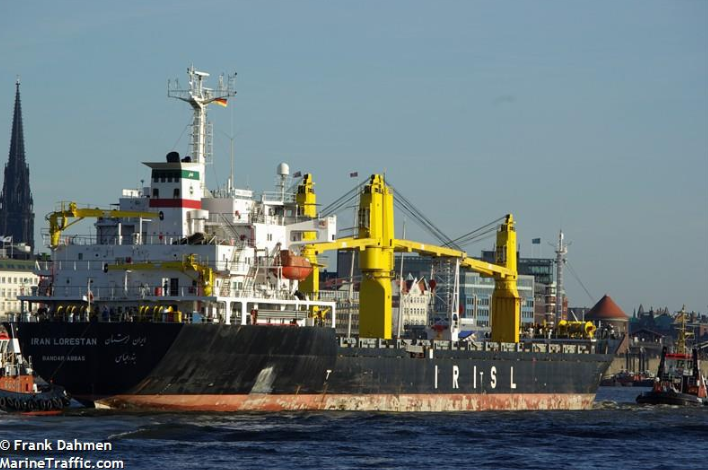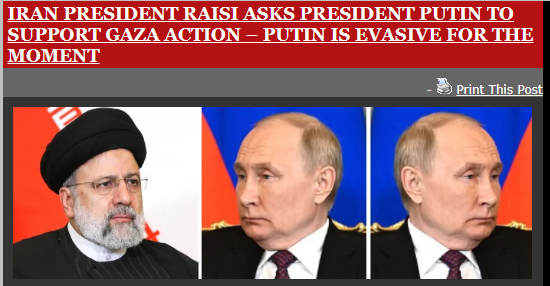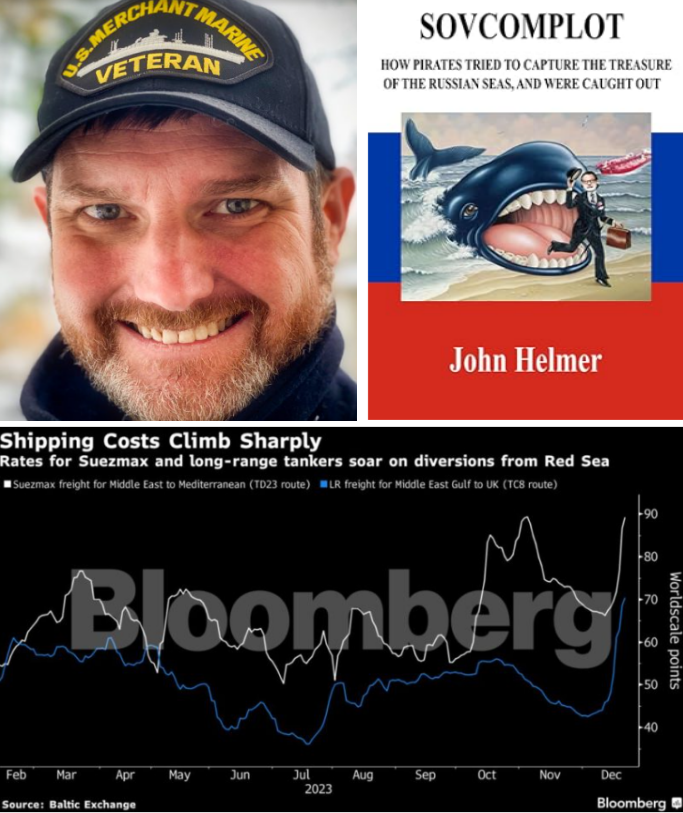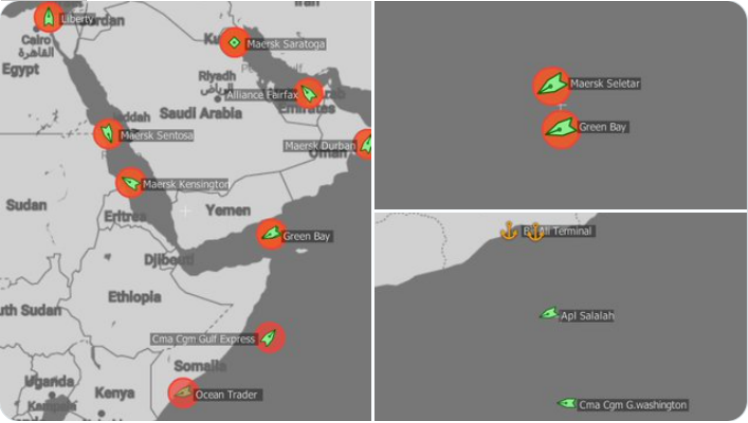Honey Trap for Israelis and Americans in the Red Sea
Honey Trap for Israelis and Americans in the Red Sea
The Iranian intelligence vessel, MV Behshad, at anchor in the Red Sea, is a honey trap intended to lure both the Israelis and US Navy into an attack, according to Russian and other sources.
The French and Spanish navies appear to anticipate or to know: they have announced they will not operate their warships in the area under US command. Instead, the French have said they will restrict their operations to guarding their own French-flagged vessels and cargoes. The French Navy also appears to have agreed to clear the backlog of Maersk container vessels trapped and no longer under way in the Red Sea and in the Gulf of Aden.
The French and similar disclaimers from Spain and Italy follow maritime media reports of acrimonious disputes between the Europeans and the US over the US priority to attack the Houthis and save Israel.
The Europeans, including the Italian and Greek navies, which have also announced they are sending warships, are following the Russian lead in secretly working out an accommodation with Iran and the Ansar Allah (Houthi) leadership for safe passage through the Bab el-Mandeb Strait in exchange for agreement to boycott Israel. In defence of their economies and shipping, support from the European allies is dwindling for Israel’s war against the Palestinians; there is no support for Israeli and American threats to expand the war against Iran and the Houthis.
The Pentagon and White House-led plan to save the Israeli port of Eilat and the Israeli economy from the long-war attrition strategy of the Arabs is collapsing. US maritime sources report “the precarious situation of US-flagged ships stranded with military cargo near the Red Sea is at the center of this coalition angst. The French want to prioritize their ships while US-flagged ships – which the US Navy is obligated to defend – are inexplicably a lower priority for the US. This urgent matter, highlighted by the recent rocket attack on a US-flagged tanker in Israel, starkly exposes the vulnerability of these vessels due to the alarming absence of adequate military protection. This critical situation not only threatens the safety of these ships but also raises profound questions about the United States’ resolve to safeguard its maritime assets, a commitment that seems to be wavering dangerously.”
Iran’s Foreign Minister Hossein Amir-Abdollahian said the decision to attack vessels in the Red Sea region is “a completely Yemeni decision in support and defence of Gaza.” He added there is no need for the US coalition operation. If “they stop supporting the murderous Israeli regime and they will see a safer region and a better situation even for the transfer of energy.”
Since the start of the Gaza war, and the engagement of Houthi forces in support of the Palestinians, the identification of the Motor Vessel Behshad was first made in the open press last Thursday. A Russian map showing the Behshad and the positions of all other state naval vessels in the area was published by Militarist, a Moscow military blogger on Thursday morning, Moscow time. It was then republished by Boris Rozhin’s Colonel Cassad. They provided no comment at the time, or since.
Follow the story here.
Click to enlarge the map and read analysis: https://johnhelmer.net/
A day earlier in Moscow, the business newspaper Kommersant reported that Russian oil shipments were continuing to move unhindered and undeterred through the Suez Canal, the Red Sea, and the Bab el-Mandeb Strait enroute to India and China. The newspaper failed to report that this required secret Russian negotiations and maritime intelligence-sharing with the Iranians and the Houthis. Read the analysis here.
This was the first overt sign that the distinction President Vladimir Putin has been making between Hamas “terrorism” and the Palestinian war for national liberation has collapsed. Publication of the Red Sea naval deployment map was the second sign. The Israeli and American threat to strike the Iranian intelligence vessel Behshad as part of their war against Houti “terrorism” is leading to a third Russian sign. It has yet to materialize.
Russian and western military sources recall the Behshad’s predecessor, the MV Saviz, also at anchor in the Red Sea, was hit by an Israeli commando raid which detonated limpet mines to sink the vessel. That was on April 6, 2021, and was reported by Iranian, Arab, British and US media at the time. The attack fell short; the Saviz did not sink, and was towed back to Iran. It was then replaced in the Red Sea by the Behshad. The Saviz has been repaired and refitted and redeployed in the eastern sector of the Indian Ocean, off India.
The Israelis, assisted by the US, have been waging a frequent sabotage war against Iranian Navy vessels, and the Iranians are well aware of it.
What signals intelligence, satellite and other information Russia is providing Iran, to be shared with the Houthis, is unknown. Unprecedented, however, is the intervention with President Putin by Igor Sechin — head of the Rosneft group, Russia’s largest oil producer and the closest of Putin’s policy advisors in the past — to place the security of Russia’s oil interests in collaboration with Iran and the Houthis above Putin’s concern for Israel. In Putin’s office, Sechin was once Turkey’s advocate for similar reasons.
How is Russia responding to the Israeli-American threat against the Behshad?
MV Saviz — https://www.marinetraffic.com/
MV Behshad – https://www.marinetraffic.com/
Intelligence-sharing with Iran is a Defense Ministry and General Staff responsibility, sharpened by deep-seated hostility towards the Israelis for their attacks in Syria against Iranian and also Russian targets, including the shoot-down of the Russian Il-20 signals intelligence aircraft in November 2018. At the time, Putin defended Israeli Prime Minister Benjamin Netanyahu over the public objections of the Defense Ministry and General Staff; read that story here.
Iran is also playing a significant role in support of Russia’s war against NATO in the Ukraine, while Israel has backed the Zelensky regime. Putin has again insisted on soft-pedaling towards Netanyahu and was cool towards Iranian President Ebrahim Raisi when they met earlier this month.
Source: https://johnhelmer.net/
Western and Russian sources think the positioning of the Behshad in the present situation is more likely to be a lure for foolhardy Israeli or US operations than it is a vulnerability on the part of the Iranian military. The record suggested by these sources is that after the Saviz incident two years ago, vessel detection and tracking in the Red Sea and Gulf of Aden have been securely transferred to hidden locations onshore in Yemen. “I suspect,” one source said, “the Behshad is a honey trap, but I’ve no idea what response the Iranians, Russians and Chinese have formulated if there is an attack on the Behshad.”
The Spanish and Italians have intimated in their announcements they want no part of such an Israeli-American operation against an Iranian target.
According to US maritime sources reporting to the US publication g Captain, “the French Navy has shifted their focus away from US-led Operation Prosperity Guardian after a representative allegedly stormed out of the operation’s first meeting with US officials. The French have begun escorting their own cargo ships, including the containerships CMA CGM Pegasus, CMA CGM George Washington and APL Salalah, through the Red Sea. At the heart of this unfolding drama is a critical question: which ships deserve protection? While the French have shown a clear intent to prioritize their own shipping interests, the US approach has left its own American-flagged ships stranded in the region, that have been – some for a full week – waiting for escort…This development marks a significant shift in the geopolitical dynamics of maritime security in one of the world’s most vital shipping lanes. The French decision underscores a growing crisis in shipping that puts national and regional priority ahead of global needs, while the US focuses on protecting all shipping – including ships owned by rivals like China – at the expense of the dwindling fleet of US-flagged merchant ships.”
gCaptain is one of the leading website and twitter publishing platforms in the US for the maritime industry; it is based in California and run by John Konrad, a professional merchant mariner and ship’s captain. He is hostile to Russia, and since the start of the Special Military Operation he has refused to report on Russian shipping or the new book, Sovcomplot.
Top: John Konrad of gCaptain; Sovcomplot, the first book on the Russian shipping in English.
Bottom: Ship charter rates have begun to jump since the start of the Gaza war, together with insurance premiums and logistics costs, as the Houthi campaign has driven global shipping away from Israel. Read more: https://gcaptain.com/
Konrad is also reporting that “sources have revealed a pervasive sense of confusion, affecting not only European shipping executives but also US shipowners who have access to classified Pentagon briefings. In interviews conducted by gCaptain, sources within the US military highlighted a disjointed response to the crisis. While certain military elements, such as the US Transportation Command (TRANSCOM) and the Navy’s Naval Cooperation and Guidance for Shipping (NCAGS), have been actively engaging with ship owners, other segments of the military appear uncertain about the command structure of the operation. This lack of clarity over leadership roles is contributing to the overall confusion surrounding the initiative…sources have revealed a pervasive sense of confusion, affecting not only European shipping executives but also US shipowners who have access to classified Pentagon briefings. In interviews conducted by gCaptain, sources within the US military highlighted a disjointed response to the crisis. While certain military elements, such as the US Transportation Command (TRANSCOM) and the Navy’s Naval Cooperation and Guidance for Shipping (NCAGS), have been actively engaging with ship owners, other segments of the military appear uncertain about the command structure of the operation. This lack of clarity over leadership roles is contributing to the overall confusion surrounding the initiative.”
Vessel location map as of December 22. As of Friday, the French Navy appears to be escorting the US-flagged Maersk Seletar and Green Bay.
Editorially, the US maritime media are trying to save themselves, and have no regard for Israel.
“The leadership vacuum needs to be filled across the pond [Atlantic] as well,” claims gCaptain. “If the operation continues under American leadership, it’s crucial for top executives of major shipping companies, such as Vincent Clerc of Maersk, to engage directly with key U.S. officials. Meetings in Washington D.C. with the Navy and Transportation Secretaries would be a pivotal move. Such collaboration would send a resounding message to mariners navigating the precarious waters under threat from Houthi drones. It would demonstrate a united front where the shipping industry, government authorities, and naval leadership are synchronizing their efforts to ensure safer seas. This is more than a strategic decision; it’s a necessary step to bolster confidence and security in these high-risk areas.”
Late on December 23, the US Central Command issued a report claiming it had responded to at least two Houthi drone attacks on oil tankers in the southern sector of the Red Sea. One of the targets was the Norwegian-flagged MV Blaamanen; it was missed narrowly. The second target was the Indian-flagged MV Saibaba, which was hit but reported no injuries. Before these strikes, the USS Laboon was targeted by at least four drones, and claims to have shot them down. It then moved to assist the tankers targeted. Two anti-ballistic missiles were also reported to have been fired in the area during the day without hitting their targets and without being intercepted.
Source: https://twitter.com/
The British maritime warning agency, UK Maritime Trade Operations (UKMTO), has issued a tweet indicating that late on Saturday afternoon of December 23, local time, a ship had been attacked in the Indian Ocean, southwest of India, by a drone. This caused an explosion and fire on the ship but no casualties.
Later reports indicate that the vessel was the Liberian flagged, Indian crewed, and “Israel affiliated” MV Chem Pluto which was carrying a cargo of crude oil from Saudi Arabia to Mangalore. The 1,600-kilometre distance from Yemen to the site attack is greater than the known ranges of Houthi drones. The Pentagon is claiming the attack “was launched directly from Iran by the Iranian Armed Forces.” An Indian media report claims the drone may have been launched by the Saviz, now reportedly located in the Indian Ocean just 87 kilometres away from the Chem Pluto.
Source: United Kingdom Maritime Trade Operations (UKMTO)
There were four UKMTO warning notices for the Indian Ocean area on December 23; altogether for the month of December so far, there have been 20 incident reports, a record for the year. For maps and incident summaries for use by mariners, ship charterers, and logistics planners, click on this UKMTO security chart.
Source: The Unz Review









Comments
Post a Comment